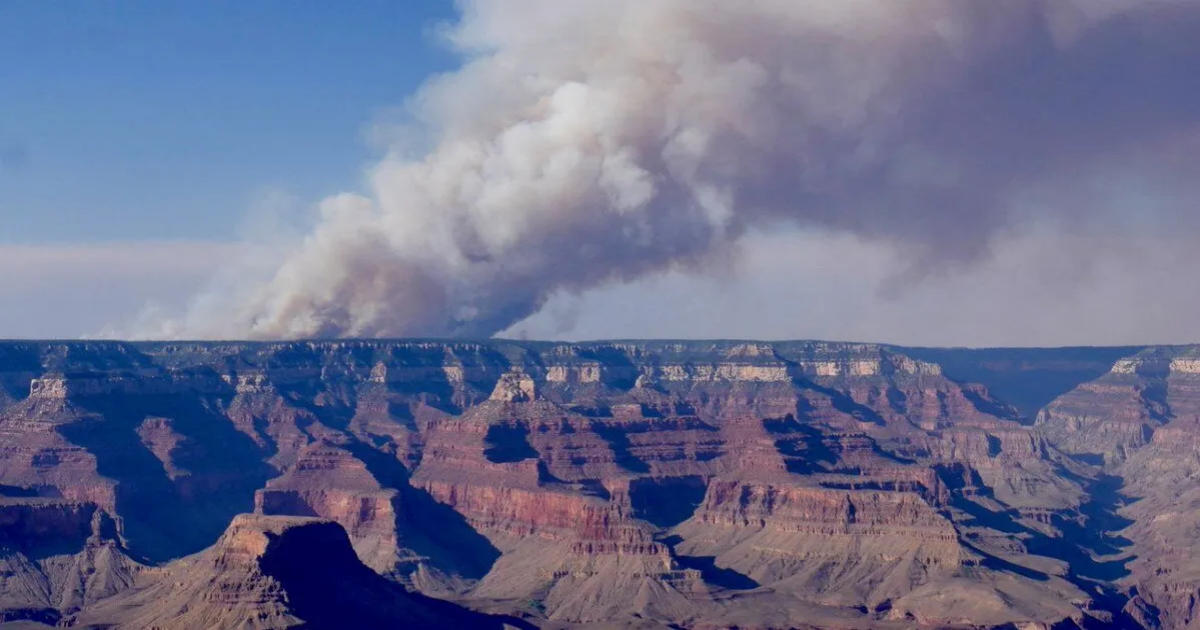
Firefighters in Arizona worked Monday to contain a pair of fast-moving wildfires that destroyed a historic lodge in Grand Canyon National Park, closed a section of the park for the rest of the season and prompted calls for an investigation into federal authorities’ wildfire response.
The two wildfires burning at or near the park’s North Rim include the White Sage Fire and the Dragon Bravo Fire. The blazes have consumed about 45,000 acres of land as of July 13.
Park officials said the Dragon Bravo Fire, which burned 5,000 acres within the park, destroyed the Grand Canyon Lodge – the only hotel located inside the national park at the North Rim. Between 50 to 80 structures have been lost in the fire, officials said, including administrative buildings, visitor facilities and other historic cabins in the park.
Lightning strikes ignited the fires this month and a combination of strong winds, low humidity and scorching daily temperatures led to their rapid expansion.
Here’s what we know about the wildfires.
White Sage Fire triggers evacuations, closures near Arizona
North of the Grand Canyon, the White Sage Fire was first reported July 9 and has steadily grown, leading to evacuation orders over a vast area, from the Kaibab Plateau to the Utah-Arizona line and the North Rim.
As of July 13, the wildfire has destroyed 40,186 acres of land and remains 0% contained, according to InciWeb, a federal government wildfire tracker. No injuries or damaged structures have been reported.
Fire officials said they made notable progress over the weekend. Containment lines near the White Sage community held as firefighters suppressed growth on the fire’s southern edge, according to InciWeb.
To the north, however, “the fire is experiencing rapid growth,” particularly in the footprint of a 2020 wildfire that temporarily closed the North Rim, officials said.
“Hot, dry, and windy conditions continue to challenge firefighting efforts,” InciWeb said.
Dragon Bravo Fire: How it started and ravaged the North Rim
The Dragon Bravo Fire was ignited by a lightning strike on July 4. Initially, fire officials sought to manage the blaze by setting up containment lines and halting its growth.
But over the weekend, powerful wind gusts up to 40 mph led the fire to expand 500 acres overnight, swallowing dozens of structures including historic cabins in the area. It also impacted a water treatment facility, leading officials to evacuate some firefighting personnel and halt aerial operations because of a possible chlorine leak.
No injuries or deaths were reported as staff and hikers were evacuated from the North Rim area before the blaze exploded in size.
Park officials said the North Rim will remain closed for the rest of the season, which runs from May 15 to October 15. Visitors to the more popular South Rim, which is open all year, were advised to stay updated on possible air quality alerts.
“The fire is being managed with an aggressive full suppression strategy,” the National Park Service said, adding, “Fire behavior is still very active.”
Grand Canyon Lodge destroyed in wildfire
The Grand Canyon Lodge sat perched on the canyon’s edge and offered guests panoramic views of the natural wonder.
The lodge opened in 1937 after the original building burned to the ground in a wildfire in September 1932. The new property was made up of the main lodge building, 23 deluxe cabins and over 90 regular cabins, according to the park service.
The lodge building was made of a limestone façade that was sourced nearby, and massive ponderosa pine trees were turned into support beams to hold up a sloped roof capable of supporting heavy loads of snow.
“We are devastated by the loss of Grand Canyon Lodge and historic buildings on the North Rim,” read a statement from the National Park Service.
Rep. Greg Stanton, D-Ariz., said on
social media that the lodge’s destruction was “Heartbreaking news for Arizona & everyone who loves this special place.”
Arizona governor calls for investigation of federal wildfire response
Arizona Gov. Katie Hobbs questioned the federal government’s handling of the Dragon Bravo Fire, which destroyed numerous structures on the North Rim of the Grand Canyon, including the historic Grand Canyon Lodge.
Hobbs said in a post on X that after a lightning strike started the fire, the federal government “chose to manage that fire as a controlled burn during the driest, hottest part of the Arizona summer.”
“I am calling on the federal government for a comprehensive and independent investigation into the management of the Fire and a report detailing the decisions that led to this devastating outcome,” she wrote.
“As someone who was born and raised in Arizona, I know what the Grand Canyon National Park means to so many people, not just in Arizona, but all over the world, and how devastating it is to see this damage done to one of Arizona’s most cherished landmarks.”
